
Pioneers come in many forms. This online exhibit shares the stories of two kinds of pioneers that made significant contributions to the Navy’s undersea communities.
Groundbreakers and trailblazers led initiatives, broke barriers, and set records. They embodied the courage and enterprising spirit needed to do something for the first time, even in the face of obstacles like racism, sexism, and other discrimination. Their achievements inspired many who hoped to follow in their footsteps and paved the way for others to build on their accomplishments.
Inventors and innovators imagined and designed new technologies, finding ways to make the “impossible” a reality. These pioneers were inventive engineers, visionaries, problem-solvers whose work advanced Navy technology, expanded Navy capabilities, and improved Navy and national safety.
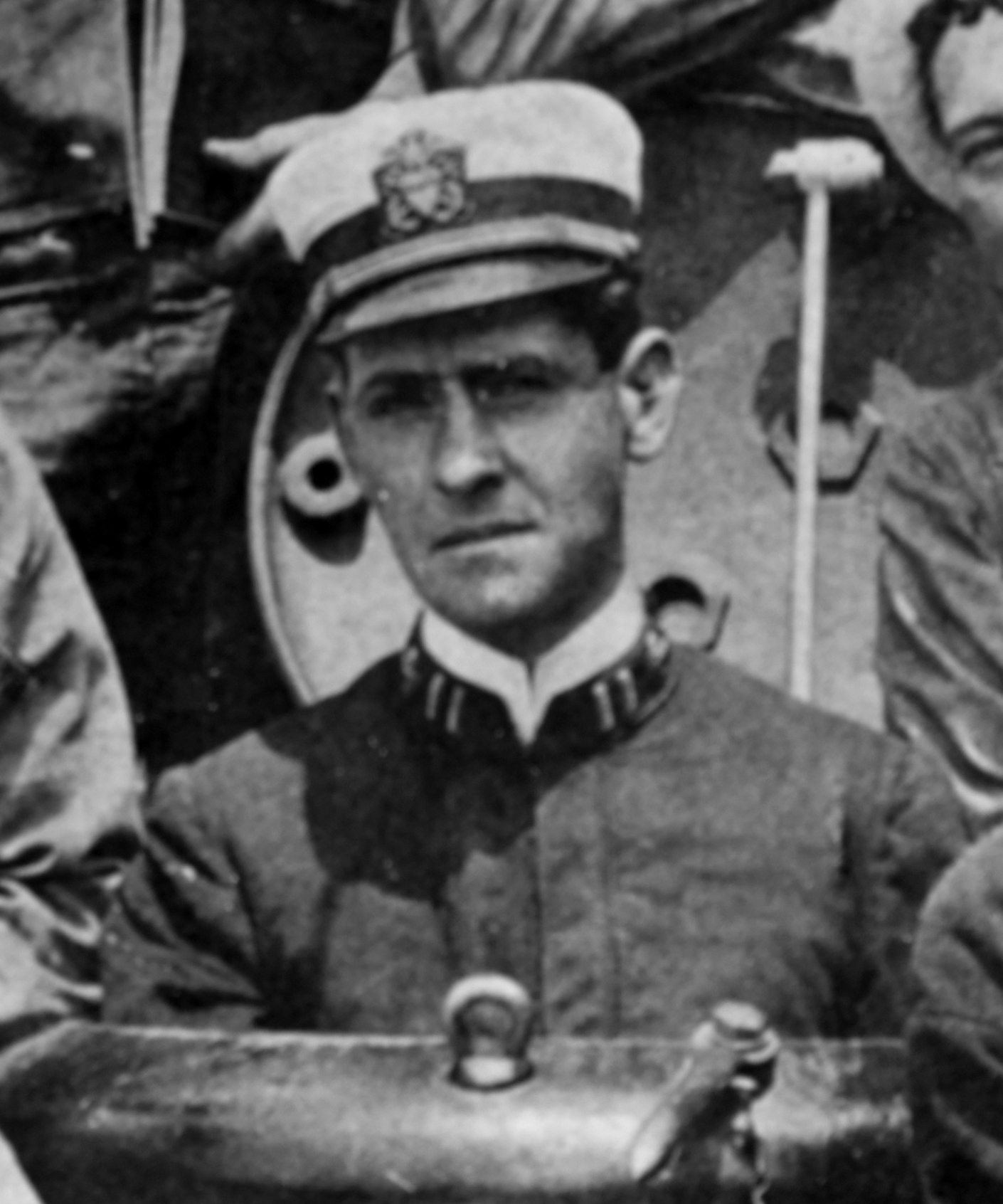
Lieutenant Harry Caldwell
First submarine commanding officer, 1900
Lt. Harry Caldwell commanded the Navy’s first commissioned submarine, USS Holland (SS 1). He graduated from the U.S. Naval Academy in 1891 and served as the flag secretary to Admiral George Dewey before and during the Spanish-American War.
In March 1900, after Admiral Dewey declined an invitation to tour USS Holland while the Navy considered purchasing her, Caldwell took his place. Impressed, he requested to serve aboard Holland and was selected as her commanding officer. Caldwell oversaw her first trial runs ahead of her October commissioning and trained future crews in submarine operation at the U.S. Naval Academy where Holland was stationed. He retired from the Navy in 1909 as a captain.
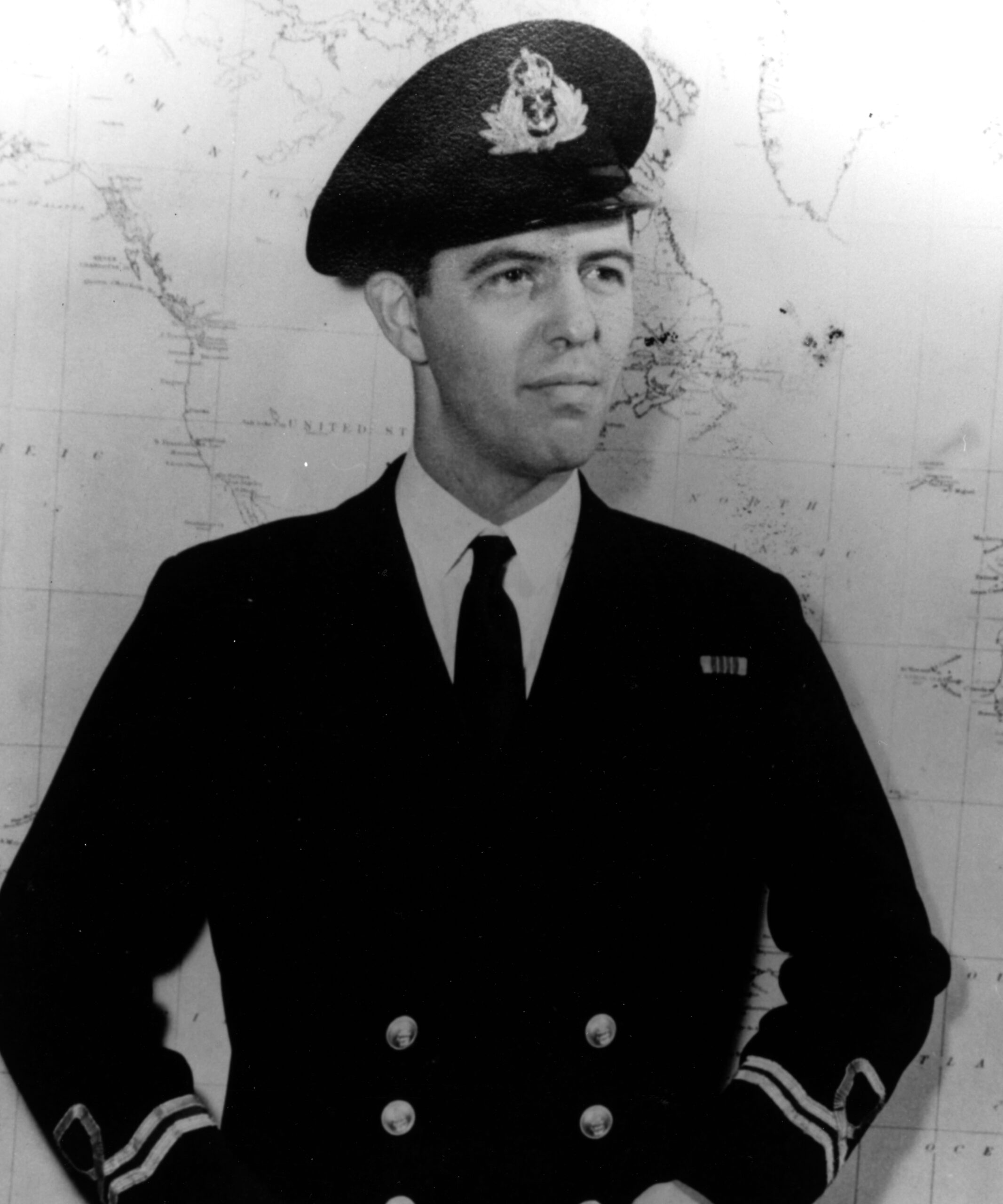
Rear Admiral Draper Kauffman
America’s “first frogman,” 1940s
Rear Adm. Draper Kauffman spearheaded combat demolition in the U.S. Navy. Forced to resign his naval commission due to poor eyesight, Kauffman joined the American Volunteer Ambulance Corps in April 1940 and then the British Royal Navy Volunteer Reserve that September. In the latter position he served as a bomb and mine disposal officer with the Royal Navy which gave him valuable experience disarming explosive ordnance. In November 1941, Kauffman accepted an appointment as a lieutenant in the U.S. Navy Reserve and began work at the Bureau of Ordnance.
In 1942, the Navy charged Kauffman with founding a U.S. Naval Bomb Disposal School at the Washington Navy Yard. Kauffman not only established the Navy’s school, he assisted the Army in creating a parallel school in Aberdeen, Maryland. The following year Kauffman established another significant first: the Naval Combat Demolition Unit (NCDU) school which trained sailors in demolitions to clear invasion sites. As Commanding Officer, Kauffman developed the school’s curriculum, which included a week of intensive training that spawned the infamous phrase “Hell Week.”
During the last two years of World War II, Kauffman worked with the Underwater Demolition Teams (UDTs), groups of combat swimmers that surveilled future amphibious landing sites and cleared them of obstacles. He served as the Commanding Officer of Underwater Demolition Team #5 and as the Senior Staff Officer and Underwater Demolition Training Officer for Amphibious Forces, Pacific Fleet. Rear Admiral Kauffman is often remembered as “America’s first frogman” for the nickname given to the combat swimmers of the UDTs and NCDUs.
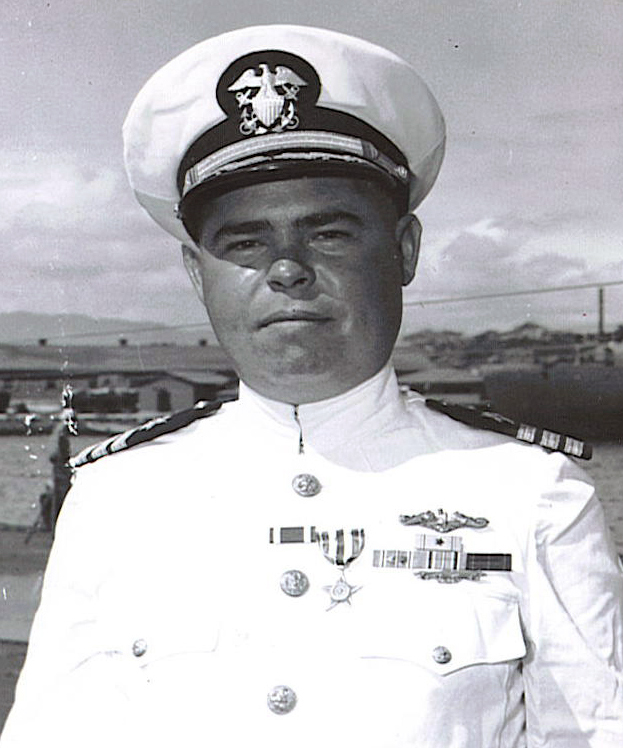
Captain Marion Frederic Ramirez de Arellano
First Hispanic American submarine commanding officer, 1944
Born in Puerto Rico in 1913 to two university professors, Marion Frederic Ramirez de Arellano attended the U.S. Naval Academy from 1931 to 1935. He made five war patrols in submarines during World War II, serving as diving officer on USS Pickerel (SS 177), executive officer on USS Skate (SS 305), and commanding officer of USS Balao (SS 285). When Ramirez took command of Balao in April 1944, as a 31-year-old lieutenant commander, he became the first Hispanic American officer to command a U.S. Navy submarine. For his World War II service, Ramirez de Arellano earned two Silver Stars, a Legion of Merit, and a Bronze Star.
Known for his humor, Ramirez de Arellano would include funny commentary in Balao’s war patrol reports. During Balao’s six war patrol, he wryly noted that, “A grim battle was waged throughout the patrol between the crew and cockroaches. At many times, the decision was in doubt.”
Captain Ramirez de Arellano retired from the Navy in July 1961 with 26 years of service. He died in 1980 at age 66.
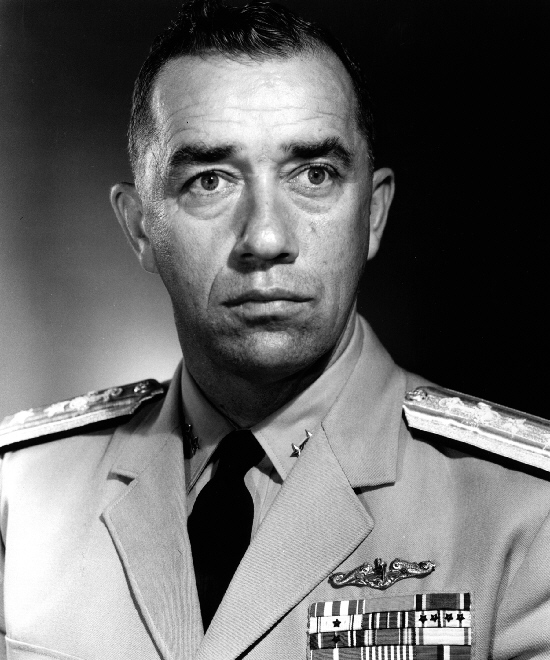
Vice Admiral Eugene “Dennis” Wilkinson
First nuclear submarine commanding officer, 1953
Vice Adm. Dennis Wilkinson commanded the world’s first nuclear-powered ship, the fast attack submarine USS Nautilus (SSN 571). Wilkinson joined the Navy Reserve as an ensign in 1940, served an officer aboard submarines during World War II, and transferred to the regular Navy in 1946. In 1948, Admiral Hyman Rickover offered him the opportunity to study atomic physics and nuclear reactors at the Oak Ridge National Laboratory in Tennessee and the Argonne National Laboratory in Illinois. Following those two years, Wilkinson commanded three diesel submarines: USS Volador (SS 490), USS Wahoo (SS 565), and USS Sea Robin (SS 407), which paved the way for his historic assignment to PCU Nautilus in mid-1953. Wilkinson held command of Nautilus through June 1957.
In September 1961, Wilkinson secured a second historic post as the commanding officer of the world’s first nuclear-powered surface ship, the guided missile cruiser USS Long Beach (CGN 9). His other notable assignments included Director of Submarine Warfare Division (1963-1966), Commander of the Atlantic Fleet Submarine Force (1970-1972), and Deputy Chief of Naval Operations for Submarine Warfare (1972-1974).
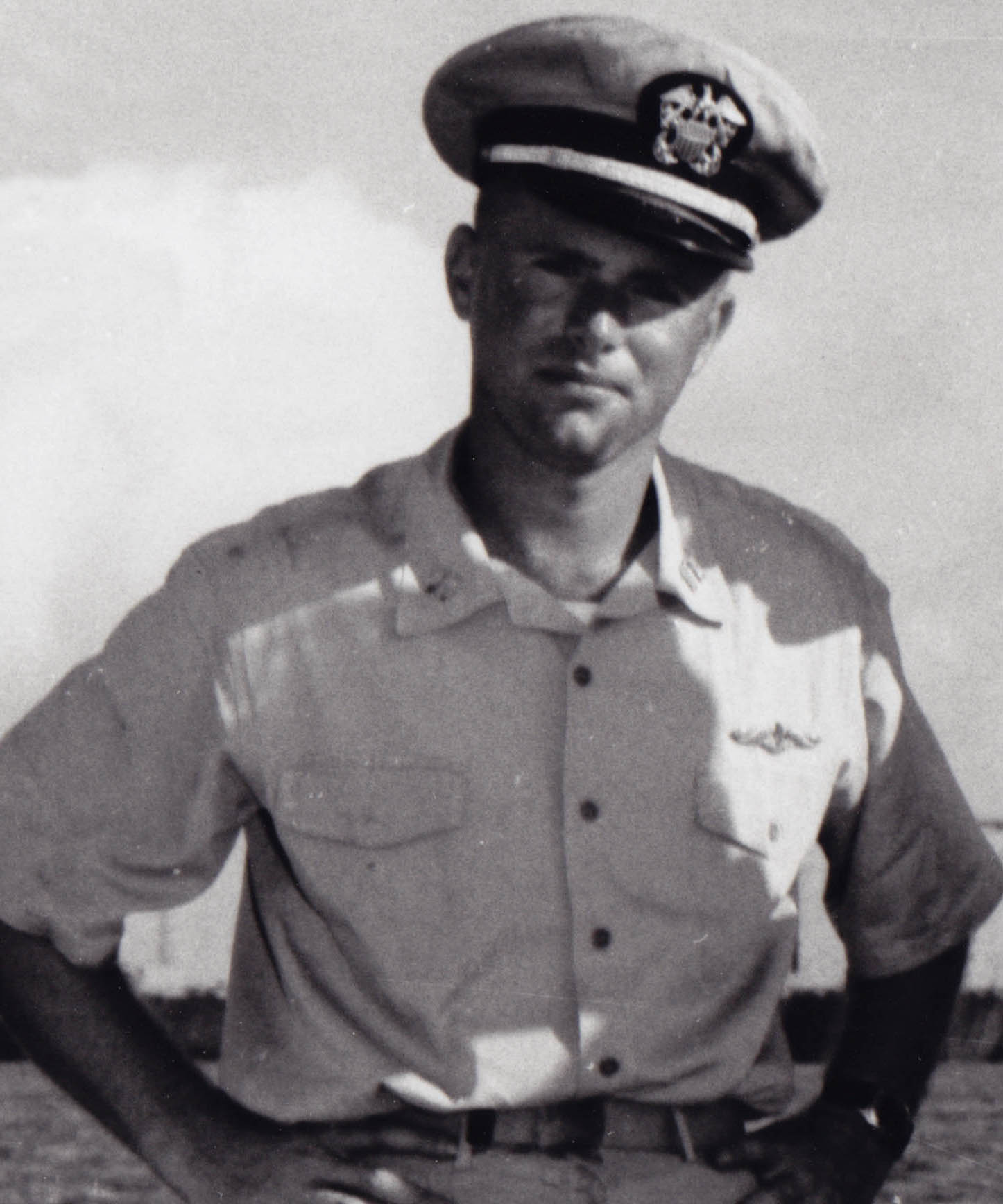
CaptAIN Don Walsh
First Navy submersible pilot, 1959
Submarine officer and oceanographer Don Walsh is best known for descending to the deepest point in the world’s oceans, the Challenger Deep in the Mariana Trench, in the bathyscaphe Trieste. At 17, he enlisted in the Naval Reserve and spent time as air crewman before attended the U.S. Naval Academy. After his vision disqualified him from becoming a pilot, he switched to amphibious forces and then submarines. In 1958, the latter led him, while on assignment in San Diego, to the Navy’s fledgling Trieste program at the Naval Electronics Laboratory. He would spend three years as the officer in charge of Trieste, becoming the first American submersible pilot and earning the Navy designation U.S. Navy Submersible Pilot #1.
On January 23, 1960, Walsh and Jacques Piccard, the son of Trieste’s inventor, piloted the bathyscaphe Trieste seven miles to the bottom of the Challenger Deep. Trieste’s landing on the ocean floor stirred up so much silt that Walsh and Piccard could see little to nothing out of the sphere’s observation window. Walsh described it as “like looking into a bowl of milk.” Their visibility remained impaired the entire 20 minutes spent at depth.
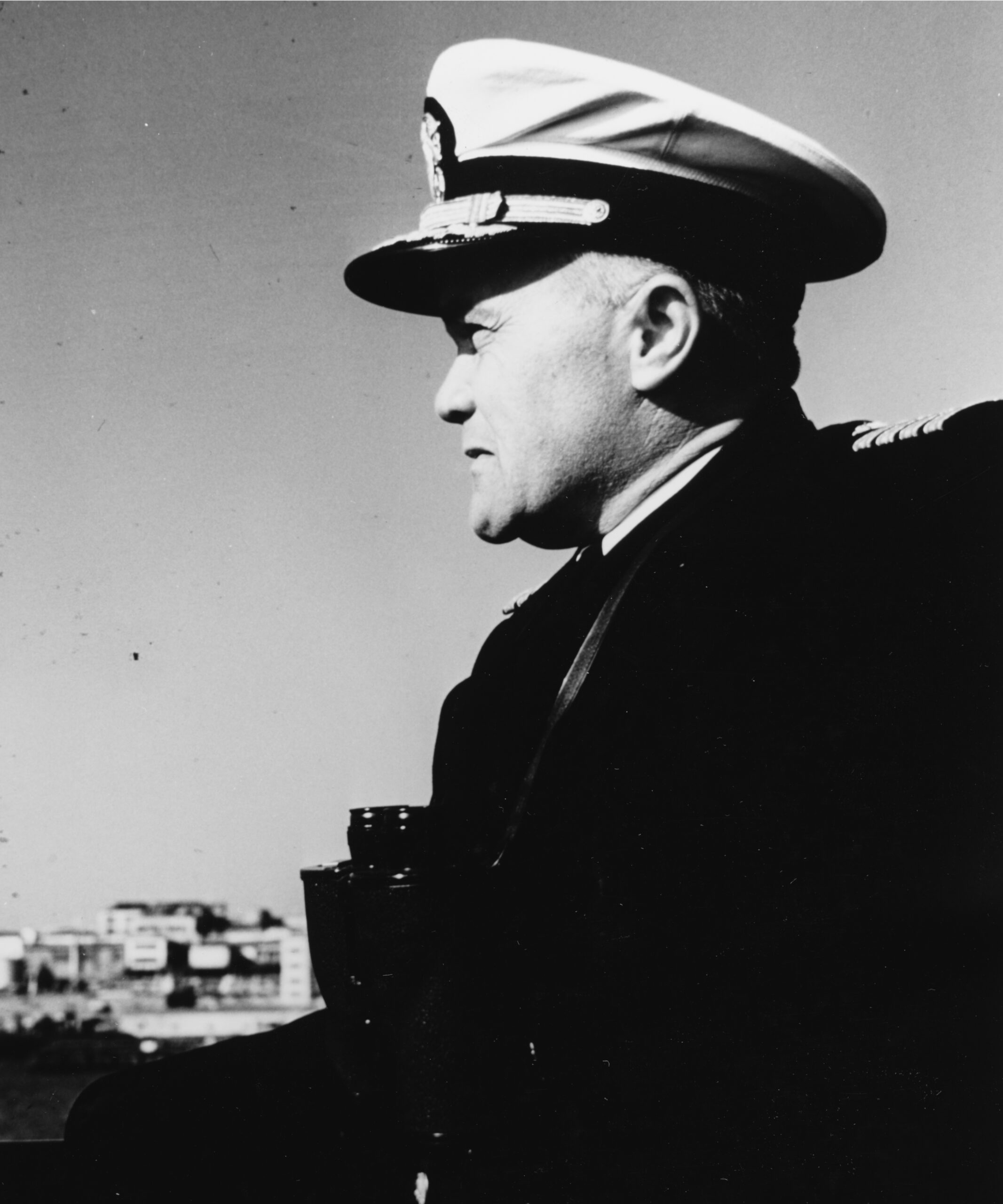
CaptAIN Edward L. Beach Jr.
Commanded first submerged circumnavigation, 1960
Submarine skipper Edward “Ned” Beach commanded the radar picket submarine USS Triton (SSRN 586) in its submerged circumnavigation around the Earth in 1960. Captain Beach graduated second in his class from the U.S. Naval Academy in 1939. During World War II he served on three submarines, including holding command of USS Piper (SS 409), completing 12 war patrols and earning 10 awards including the Navy Cross. After the war he commanded three more subs before assuming command of USS Triton in 1959.
To demonstrate the capability of nuclear-powered submarines and showcase America’s technological capabilities ahead of a Cold War-driven summit, Triton was chosen to carry out a fully-submerged voyage around the globe as her shakedown cruise. Triton was the largest submarine in the world at the time, and the only American submarine powered by two nuclear reactors. Beach and his crew completed the circumnavigation in 60 days, earning Triton a Presidential Unit Citation and Beach a Legion of Merit.
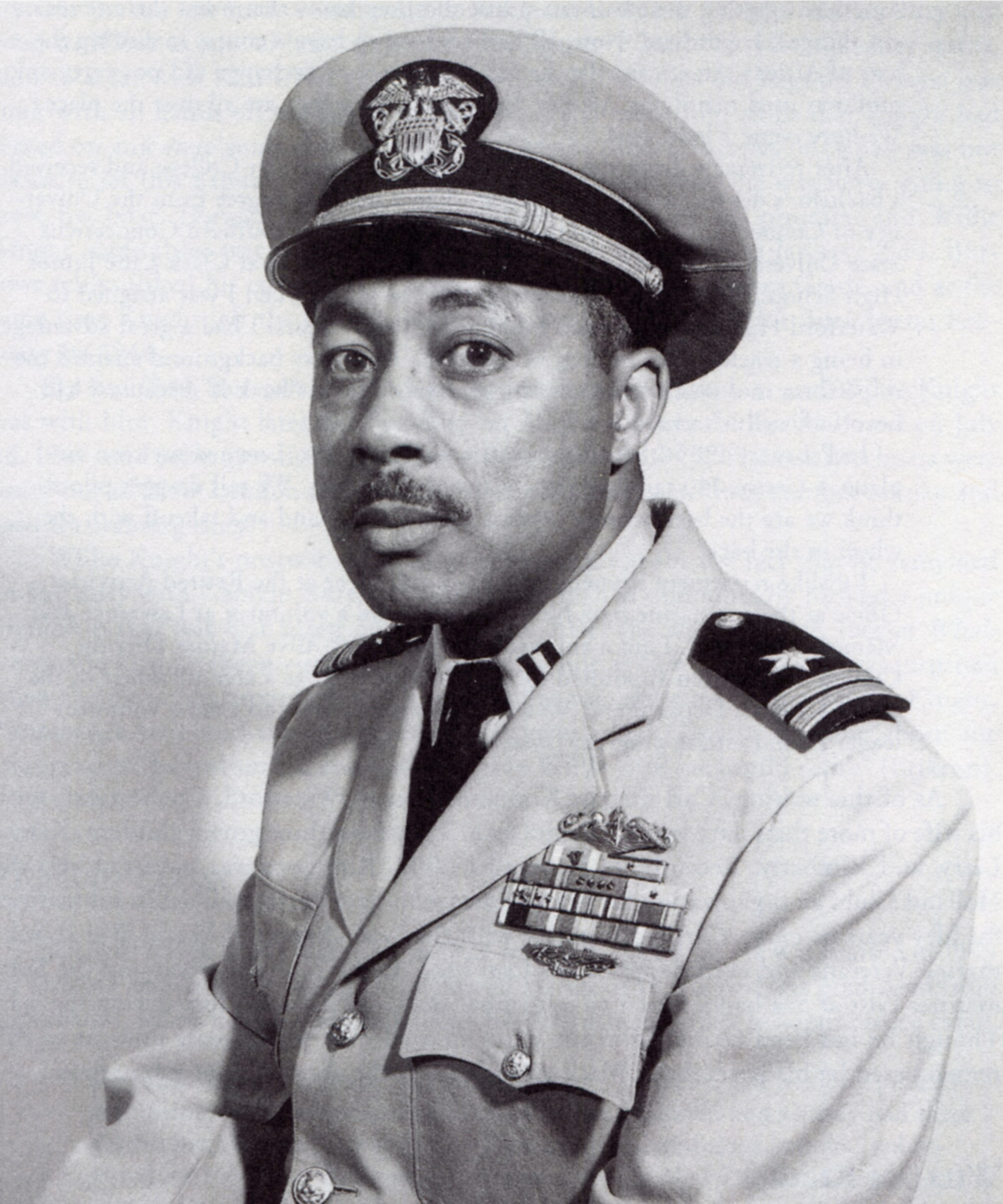
Lieutenant Carl Kimmons
First Navy mess attendant to serve in all enlisted ranks and become a commissioned officer, 1961
Lieutenant Carl Kimmons was the first and only U.S. Navy mess attendant to serve in all enlisted ranks (Seaman Recruit through Master Chief) and become a commissioned officer.
Kimmons enlisted in 1940 at age 20 and made four war patrols on USS Plunger (SS 179) and three on USS Parche (SS 384) during World War II. After all rates were opened to Black service members, Kimmons became one of the first stewards to change ratings in October 1947. His transfer to yeoman was only permitted because he accepted a demotion to a second class petty officer.
As a yeoman, Kimmons served aboard USS Medregal (SS 480) and USS Sea Robin (SS 407), rising to the rank of master chief by the late 1950s. In 1961, Master Chief Kimmons was selected for the “Chief to JG” program, attended Officer Candidate School, and was commissioned as a limited duty officer. In this capacity, he served at the Naval Submarine School, Submarine Development Group Two, and Navy Underwater Sound Laboratory before retiring as a lieutenant in 1970 with 30 years of service.
Post-Navy, Kimmons earned a master’s degree and taught social studies for 22 years. He was also a pilot who flew his personal airplane, a Cessna 140 tail dragger, for 26 years. Kimmons died in 2016 at age 96.
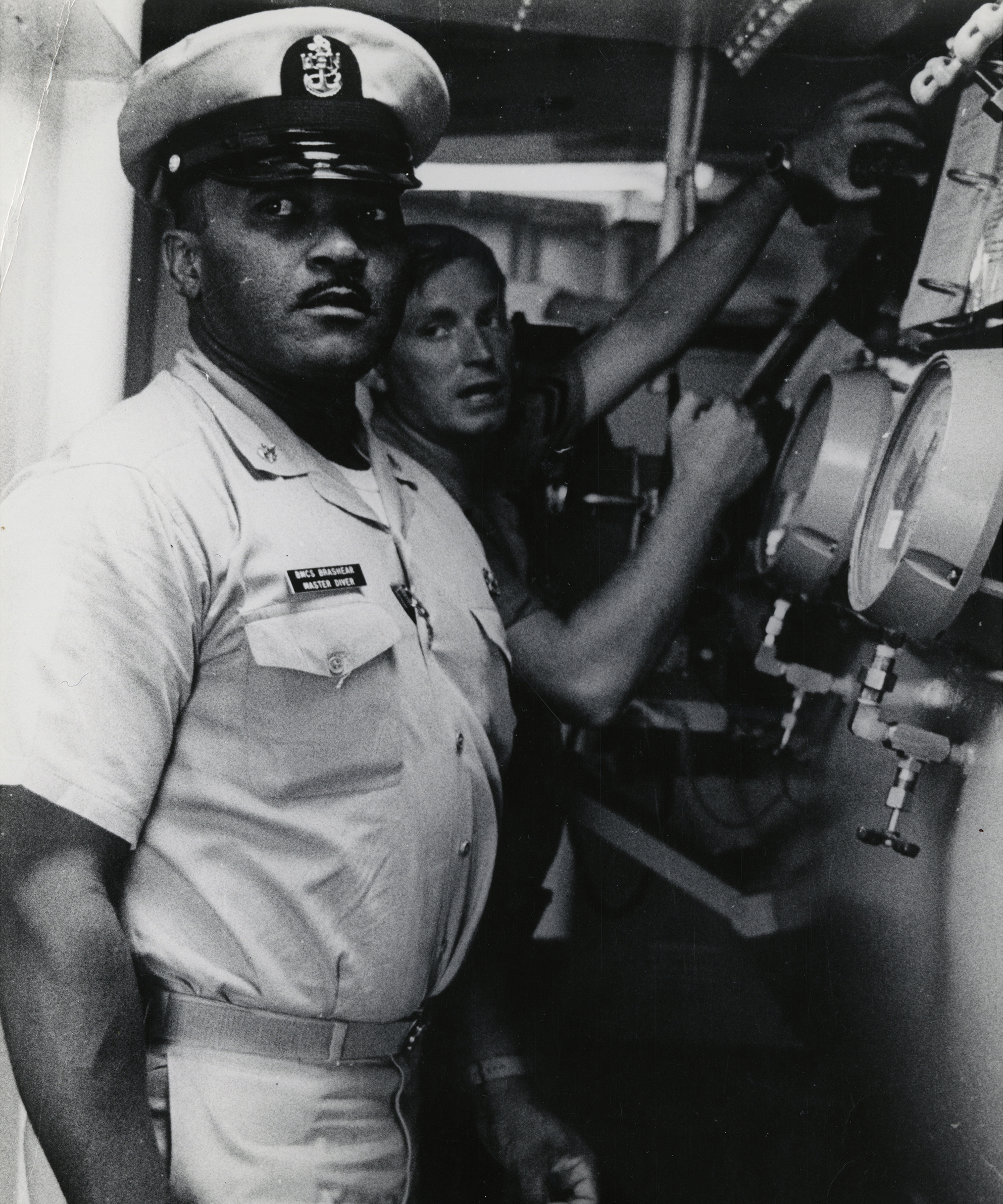
Master Chief Boatswain’s Mate Carl Brashear
First African American Navy Master Diver, 1970
First Navy amputee diver, 1970
Master Chief Boatswain’s Mate Carl Brashear was the Navy’s first African American Master Diver and first amputee diver. Brashear enlisted in the Navy in 1948 and initially served as a steward — one of the only ratings open to African Americans at the time. After observing a salvage operation in 1950, he decided to become a diver and petitioned to attend dive school for four years before being admitted. Brashear completed salvage dive school in 1954, despite experiencing harassment, hazing, and other threats, and went on to qualify as a first-class diver in 1964.
In 1966, while assisting with the hydrogen bomb recovery, Brashear was seriously injured by a falling steel pipe that struck him in the leg as he pushed another sailor out of harm’s way. He elected to amputate his leg after learning the injury could take up to four years to heal. Following the amputation, Brashear spent a year under evaluation before he was returned to full duty. In 1970, he qualified as the first African American Master Diver in the Navy. Master Diver Brashear retired from the Navy in 1979 with 31 years of service.
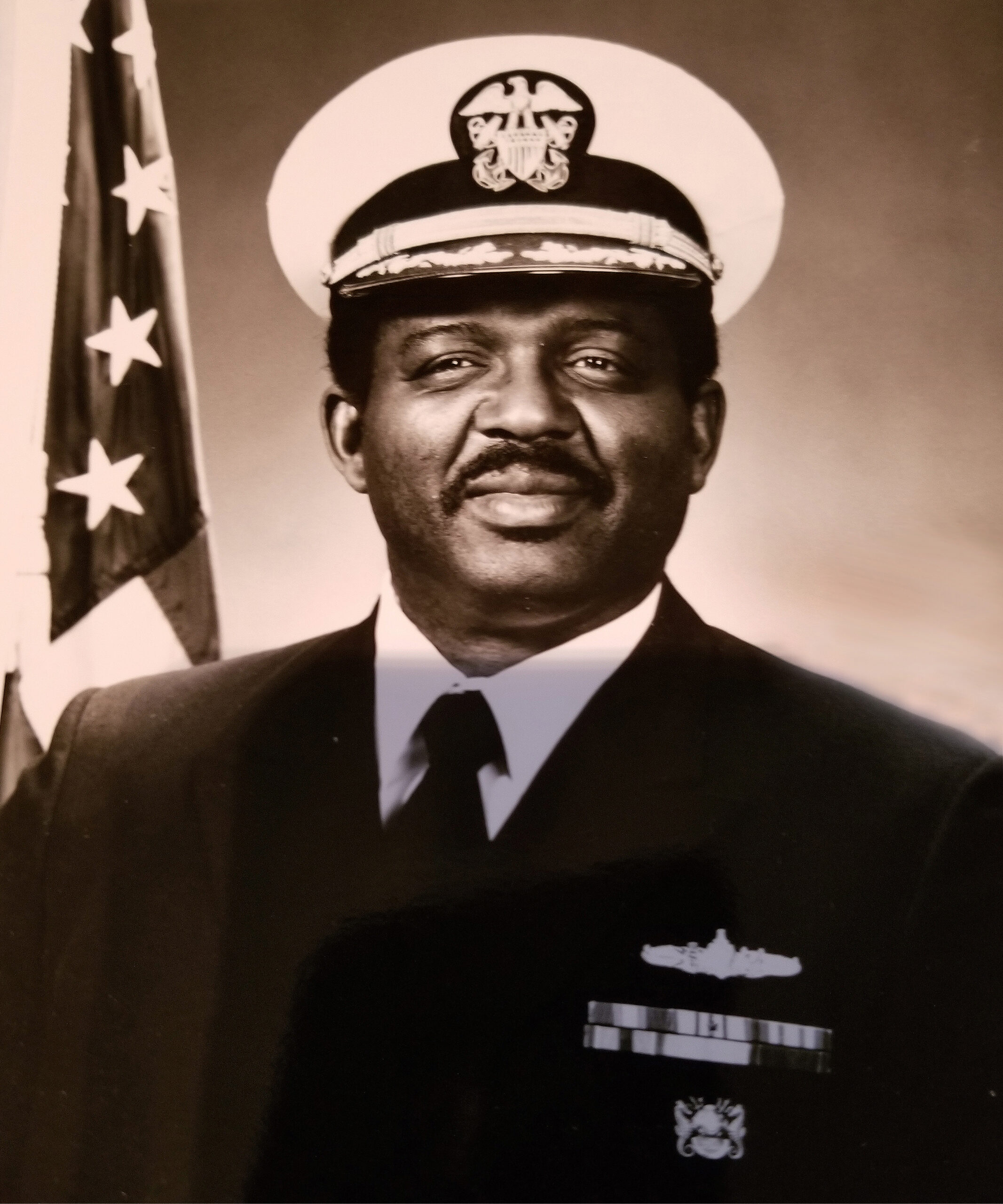
Image courtesy of Captain Dunlap
Captain Billy Wayne Dunlap
First African American Navy Diving and Salvage Officer, 1972
First African American Special Operations Officer, 1977 or 1978
Captain Billy Wayne Dunlap became the U.S. Navy’s first African American Diving and Salvage Officer when he graduated from salvage diving officer school in June 1972.
Captain Dunlap served in both the Naval Reserve and on active duty for more than twenty years. At sea, his assignments included serving aboard USS Lipan (ATF 85), USS Cocopa (ATF 101), where he earned his surface warfare qualification, and USS Schofield (FFG 3).
During a tour at the U.S. Naval Academy, Captain Dunlap transferred to the special operations community and qualified as the first African American Special Operations Officer. Ashore, among many assignments, he commanded Naval Reserve Weapons Station Earle, Naval Reserve EOD Facility Detachment 106, and Naval Reserve Mobile Diving and Salvage Unit Two Detachment 506.
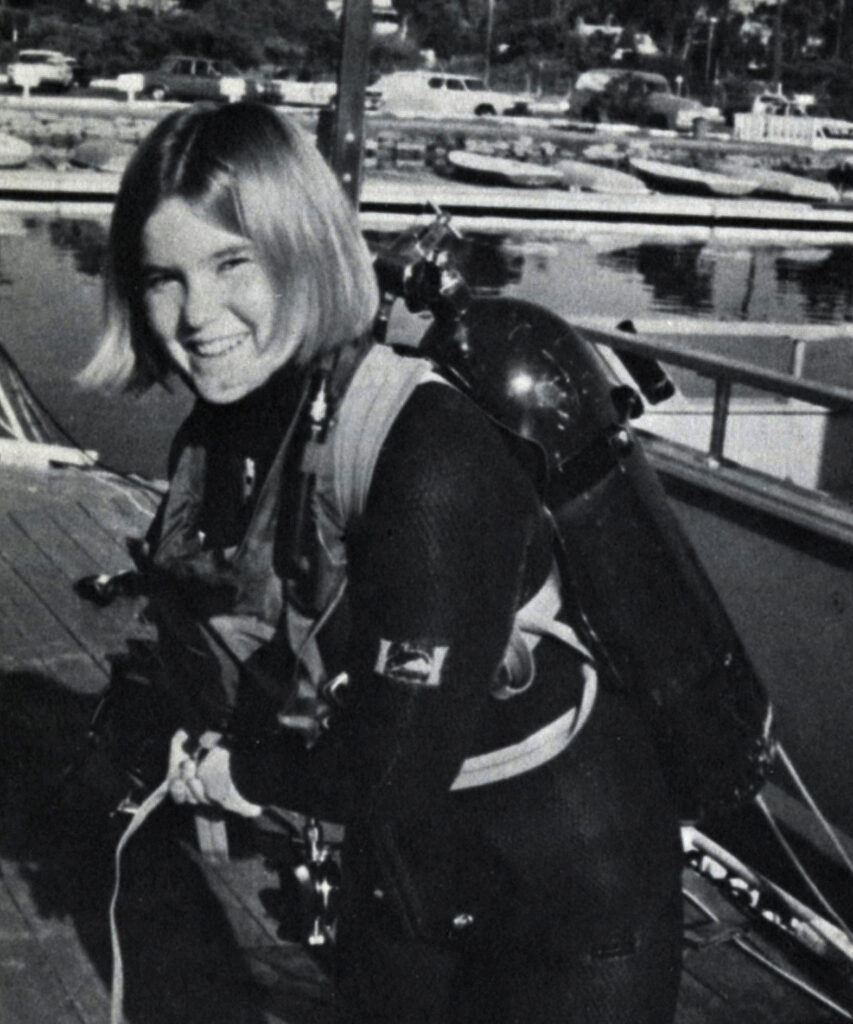
Personnelman Seaman Kati Garner
First female Navy SCUBA diver, 1973
Personnelman Seaman Kati Garner was the first woman to graduate U.S. Navy SCUBA diving school. When the Navy sought women for dive training in 1973, Garner jumped at the chance, bored with her WAVES typewriting classes. She found a trainer and mentor in Chief Robert Diecks, Swim Coordinator at the Recruit Training Center. Chief Diecks created a conditioning program to prepare Garner for the rigors of dive school. For three months, Garner met Chief Diecks every morning at 6:00 AM to run, swim laps, and do pushups, sit-ups, flutter kicks, and calisthenics.
By the time SCUBA school began on November 5, Garner was ready. She slogged through four weeks of physical tests — all the exercises she practiced during her conditioning and more, including mud runs and games of leapfrog.
Garner graduated on November 30, 1973, qualifying as the Navy’s first female SCUBA diver. She went on to work at the Navy’s Water Survival Department and the Marine Mammal Program.
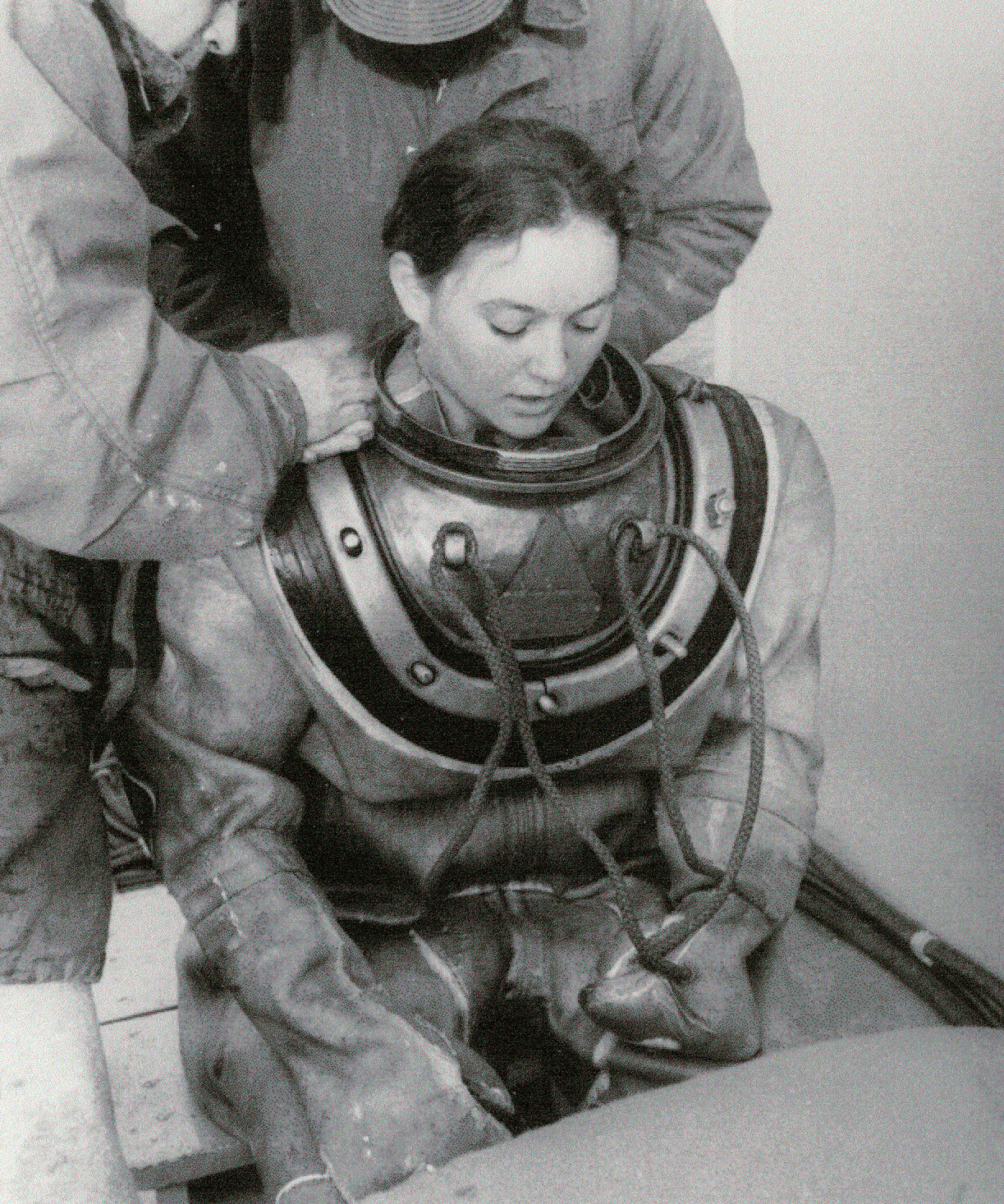
Hull Technician Fireman Donna Tobias
First female Navy deep-sea diver, 1975
Hull Technician Fireman Donna Tobias made history in 1975 when she graduated from Second Class Diving School and became the Navy’s first female “hard hat” diver. Tobias joined the Navy in 1974 to be a diver. After months of effort, she secured a gender waiver that allowed her to attend dive school. Half the students quit the 10-week course, but Tobias knew she was going to finish the class. “I told myself they’d have to make me leave. I wouldn’t quit. If you ever uttered the words, ‘I quit,’ you could never take them back, and there were plenty of eyes waiting to see me fail. I didn’t want them asking less of women, for anything.” She graduated from Second Class Dive School on March 14, 1975, making her the Navy’s first woman deep sea diver.
Despite this accomplishment, Tobias had limited assignment options — sea duty billets wouldn’t open to women until three years later, in 1978. She took a position as an instructor at the Submarine Escape Training Tank at Submarine Naval Base New London, where she taught submariners escape techniques. During these years she also took part in experimental physiological research and helped evaluate the Navy’s new MK 12 diving system.
>> Read more about Donna Tobias here
>> View Donna Tobias artifacts in our collection
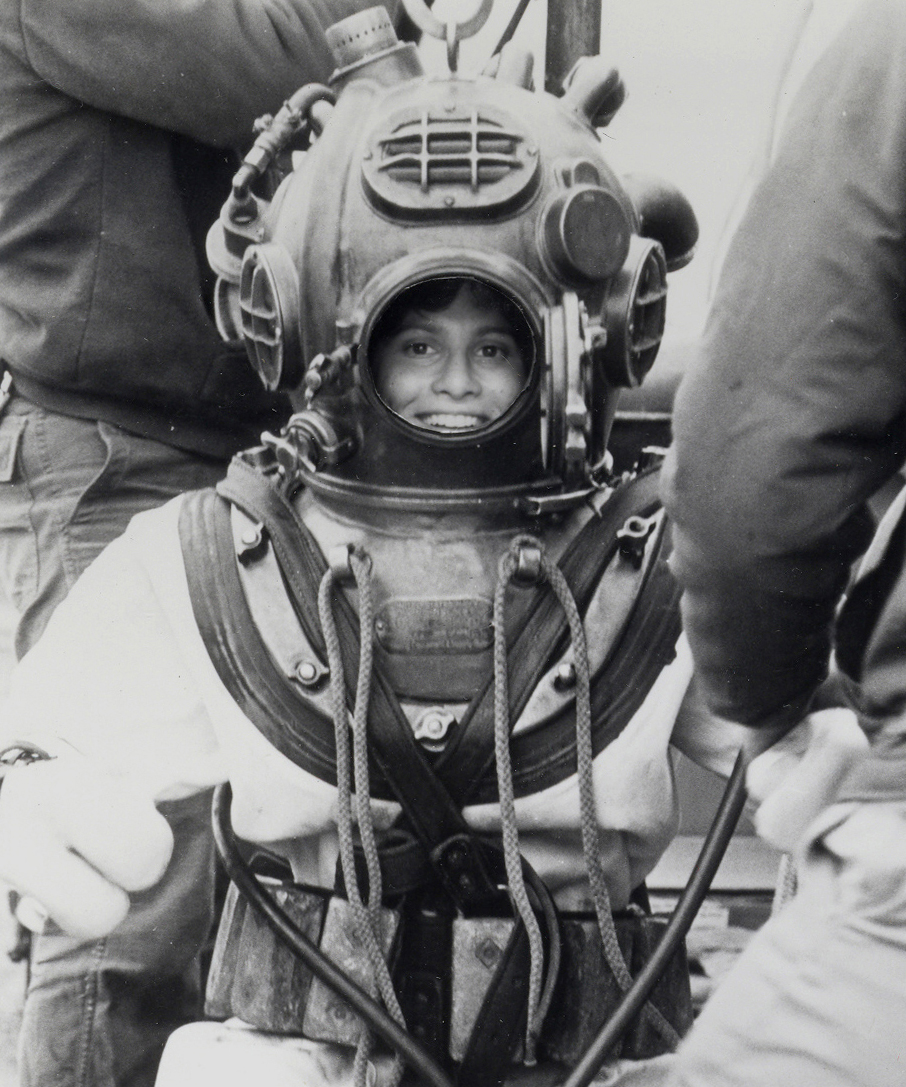
Commander Sue Trukken
First female Navy diving officer, 1980
First female Navy saturation diving officer, 1982
Commander Sue Trukken joined the U.S. Navy in 1978. Upon discovering sea duty was mostly closed to women, she decided to become a diver. “It was a win/win for me. I was able to do something for the Navy and also do something that I really loved to do.”
Trukken graduated from the Naval School of Diving and Salvage in January 1980 to become the Navy’s first female diving officer. During a tour at the Navy’s Experimental Diving Unit, she became the first woman to qualify as a Navy saturation diving officer. From 1989 to 1992, she served as Executive Officer of Mobile Diving and Salvage Unit Two, and as Executive Officer at the Naval Diving and Salvage Training Center in Panama City, Florida, from 1994 to 1996.
“Overall, my Navy diving experience was excellent, challenging, and a real pleasure to work with like-minded people,” she later reflected. “I can’t think of a better group of problem-solvers and go-getters than Navy divers.”
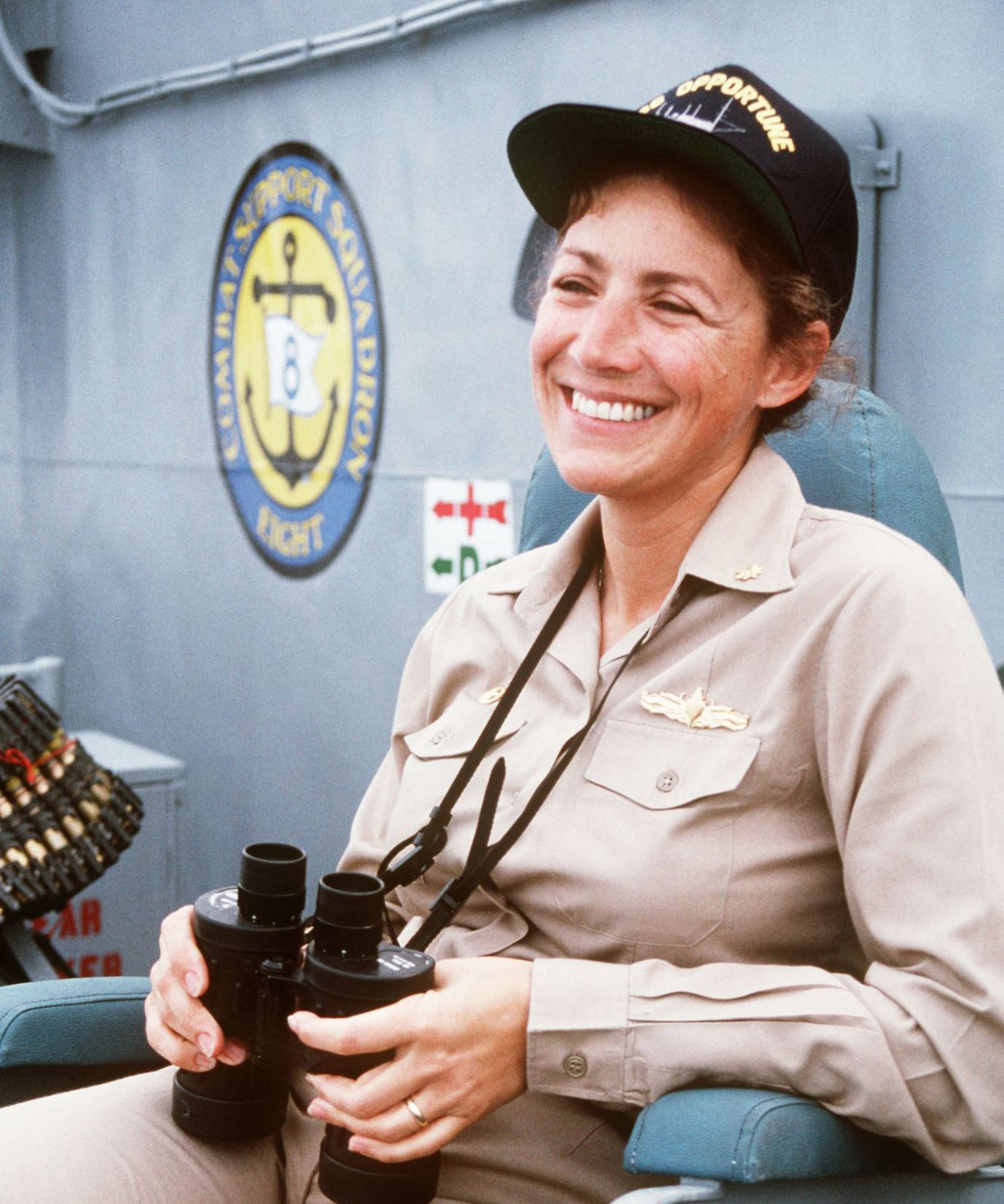
Commander Darlene Iskra
One of the first female Navy diving officers, 1980
First woman to command a U.S. Navy ship, 1990
Diving officer Lieutenant Commander Darlene Iskra made history in December 1990 when she became the first woman to command a U.S. Navy ship. Iskra took command of salvage ship USS Opportune (ARS 41) in Naples, Italy.
“I knew I was the first [female commanding officer] and I felt a responsibility to show that equal opportunity works in the Navy,” reflected Iskra, who was also one of the first three women to qualify as a Navy diving officer. She graduated from the Naval School of Diving and Salvage in May 1980 and Surface Warfare Officer School later that year. As a diving officer and surface warfare officer, Commander Iskra served aboard USS Hector (AR 7), USS Grasp (ARS 51), and as executive officer of USS Preserver (ARS 8) and USS Hoist (ARS 40) before assuming her historic command of Opportune.
After retiring as a commander in 2000 with 21 years of service, Iskra went on to earn two master’s degrees and a Ph.D., and to write multiple books about women in the military.
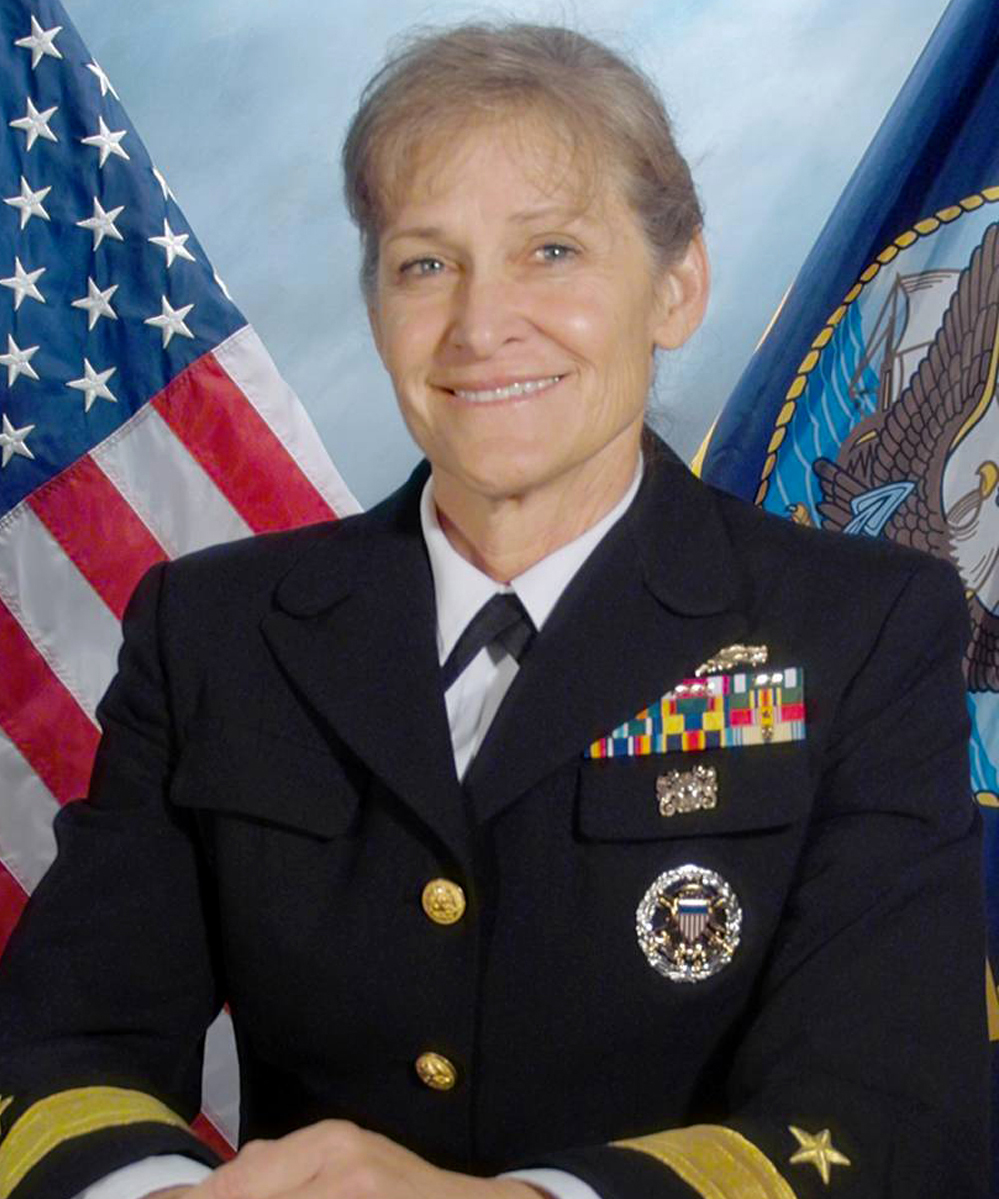
Rear Admiral Martha Herb
One of the first female Navy diving officers, 1980
First female Navy diving officer promoted to rear admiral, 2010
Rear Admiral Martha Herb was one of the first female officers to graduate from the Navy School of Diving and Salvage in 1980. She was the first woman at Mobile Diving and Salvage Unit One to direct the Navy’s Underwater Hull Cleaning program, and one of the first women to qualify as a Surface Warfare Officer. Rear Admiral Herb also served as the first female Officer in Charge of the Second Class Diving School for the Naval Surface Forces in the Atlantic Fleet.
In 2010, she was promoted to rear admiral — the first female diving officer to hold this rank. Rear Adm. Herb retired in 2018 with almost three decades of service.
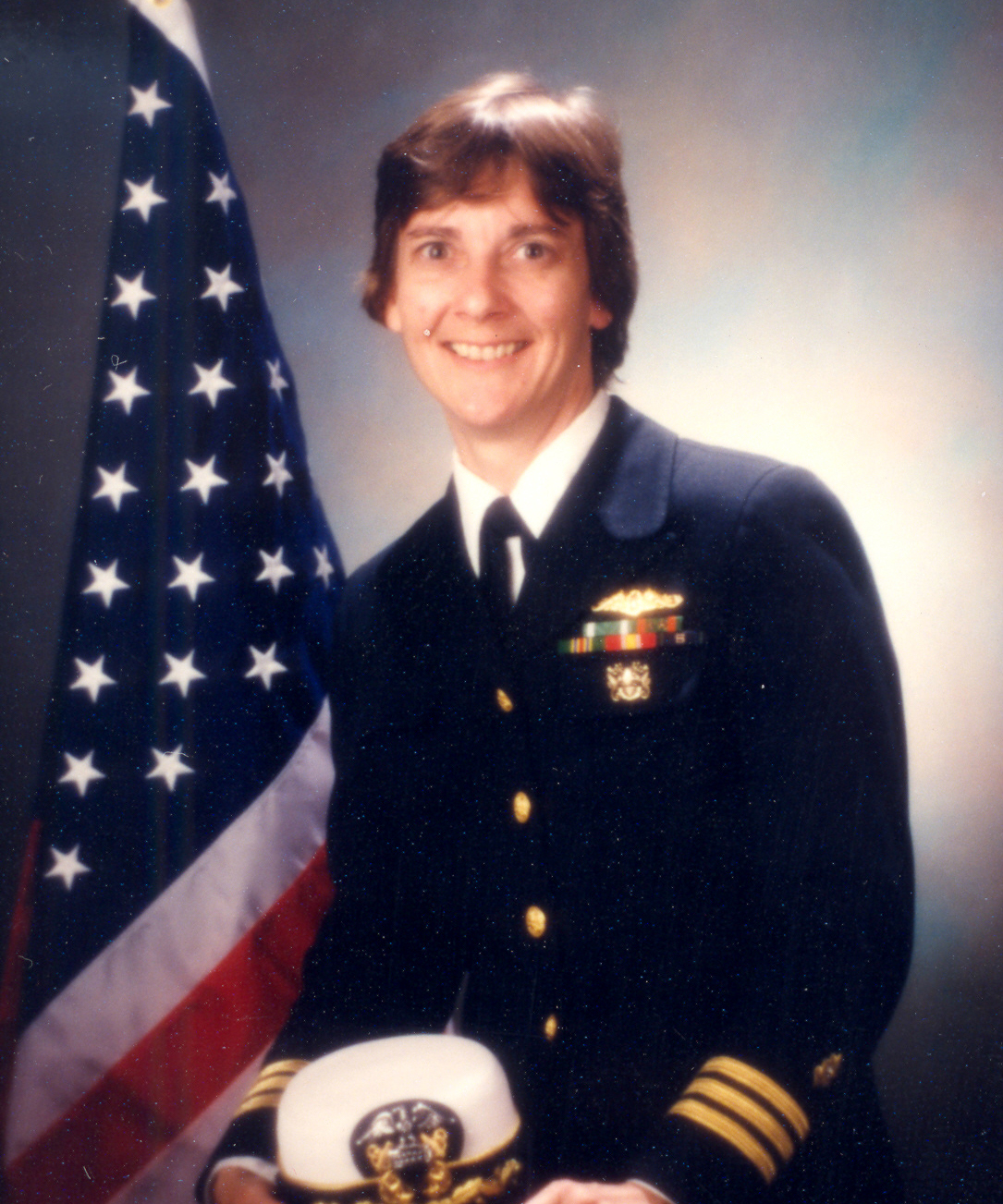
Captain Marie Knafelc, MD
First female Navy saturation diving medical officer, 1980
First female Submarine Medical Officer, 1981
Captain Marie Knafelc earned her doctorate in medicine in 1980 and joined the U.S. Navy as an Undersea Medical Officer with the Navy Experimental Diving Unit. She qualified in SCUBA, mixed gas, and saturation diving.
In 1981, Knafelc completed the requirements to become the first female Submarine Medical Officer, training and qualifying aboard USS Casimir Pulaski (SSBN 633). When the submarine squadron declined to award her medical dolphins, Knafelc persisted with a letter of recommendation and special fitness report from Casimir Pulaski’s commanding officer. She received her dolphins in 1982. Five years later, Knafelc qualified as the first female saturation diving Medical Officer.
From 1992 to 2002, Capt. Knafelc served as the Senior Medical Officer/Medical Director for the Navy Experimental Diving Unit. She was inducted into the Women Divers Hall of Fame in 2002, and retired from the Navy in 2004 with 24 years of service.
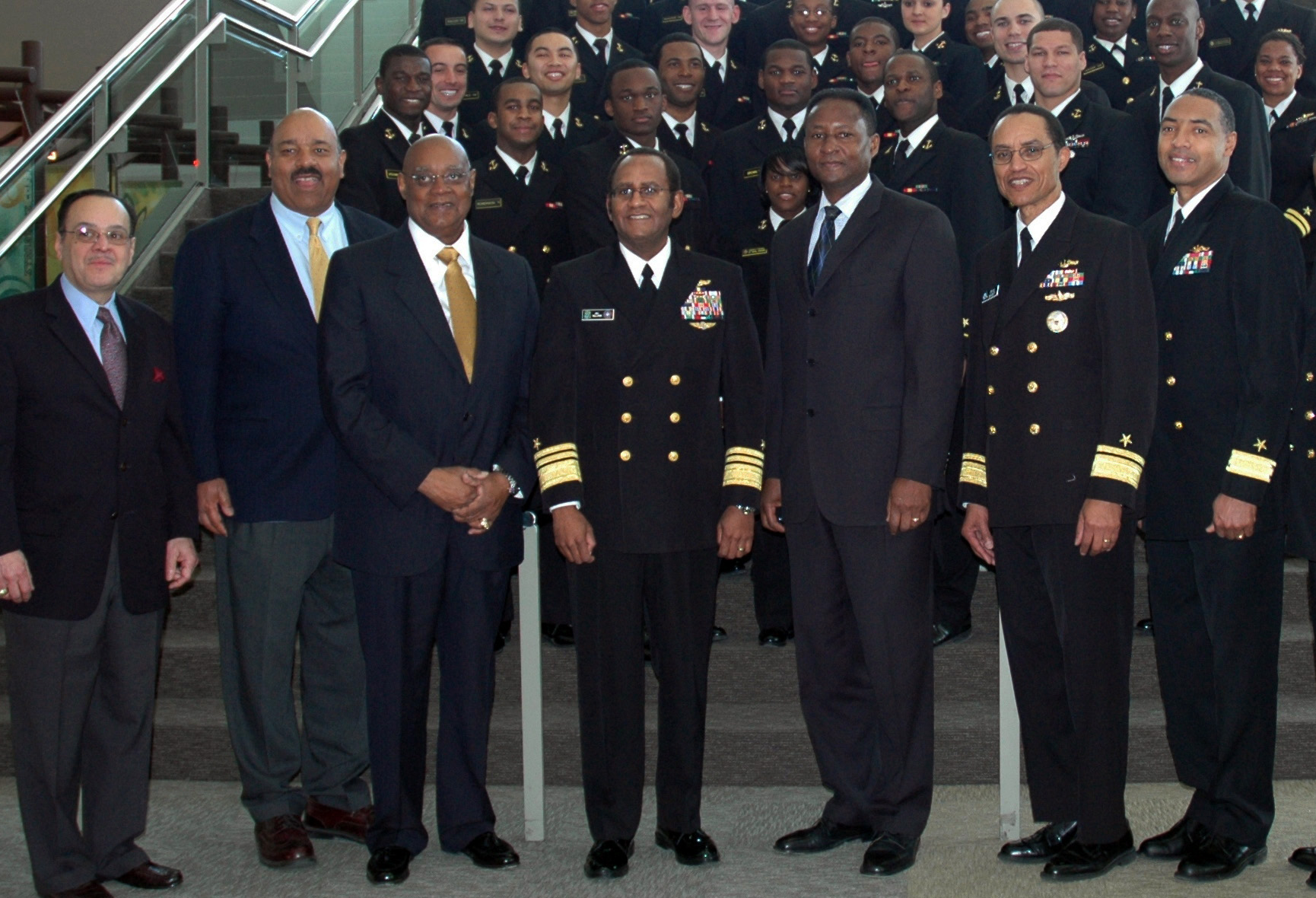
From left to right: Captain Pete Tzomes, Rear Admiral Tony Watson, Commander Will Bundy, Vice Admiral Mel Williams Jr., Captain Joe Peterson, Admiral Cecil Haney, and Vice Admiral Bruce Grooms.
The Centennial Seven
The first seven African American submarine commanding officers, 1983 to 1997
During the first 100 years of the Submarine Force (1900–2000), seven African American officers commanded Navy submarines. The seven men have come to be known as the “Centennial Seven” and have been mentoring junior officers of all races considering the Nuclear Propulsion Program and submarine service.
Captain C.A. “Pete” Tzomes became the first African American submarine commanding officer when he assumed command of the fast attack submarine USS Houston (SSN 713) in May 1983. Captain Tzomes was only the second African American accepted into the Navy’s prestigious Nuclear Propulsion Program, and the first for submarines. Four years later, Rear Admiral Tony Watson took command of USS Jacksonville (SSN 699). Watson also holds the distinction of being the first African American submarine officer promoted to rear admiral. Commander Will Bundy was the first enlisted African American to become a submarine commanding officer; he assumed command of USS Barbel (SS 580) in 1988.
In 1994, two more African American officers earned submarine commander positions. Vice Admiral Mel Williams Jr. commanded USS Nebraska (SSBN 739) (Gold) from 1994 to 1997. Captain Joe Peterson, another enlisted submariner later commissioned as an officer, held command of USS Dolphin (AGSS 555) from 1994 to 1997 as well. Admiral Cecil Haney, a classmate of Vice Admiral Mel Williams Jr. at the Naval Academy, assumed command of USS Honolulu (SSN 718) in June 1996. Admiral Haney was also the first African American Director of Submarine Warfare at the Pentagon. The seventh member of the Centennial Seven, Vice Admiral Bruce Grooms, joined the elite group when he took command of USS Asheville (SSN 758) in 1997.
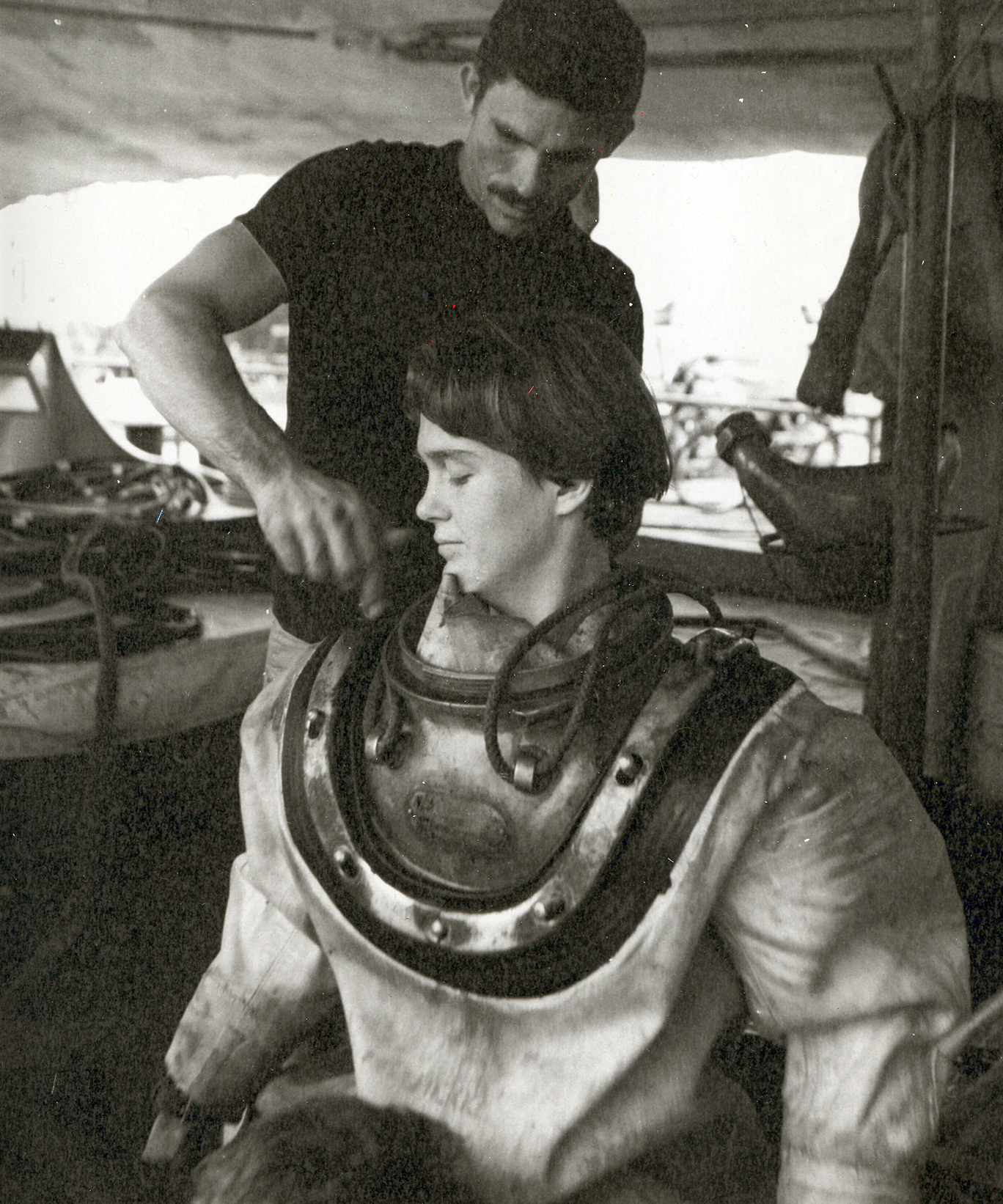
Master Chief Electrician’s Mate Mary Bonnin
First and only female Navy Master Diver, 1990
Master Chief Electrician’s Mate Mary Bonnin earned her initial diving qualification in 1977. When she graduated from First Class Diving School in 1981 at the top of her class, she received the Honor Person designation and became the first woman to qualify as a Diver First Class.
During the seven years she spent as a Navy diving instructor, Master Chief Bonnin trained more than 1,000 divers. In 1990, she earned the qualification of Navy Master Diver and remains the only woman to do so. She was inducted into the Women Divers Hall of Fame in 2001.
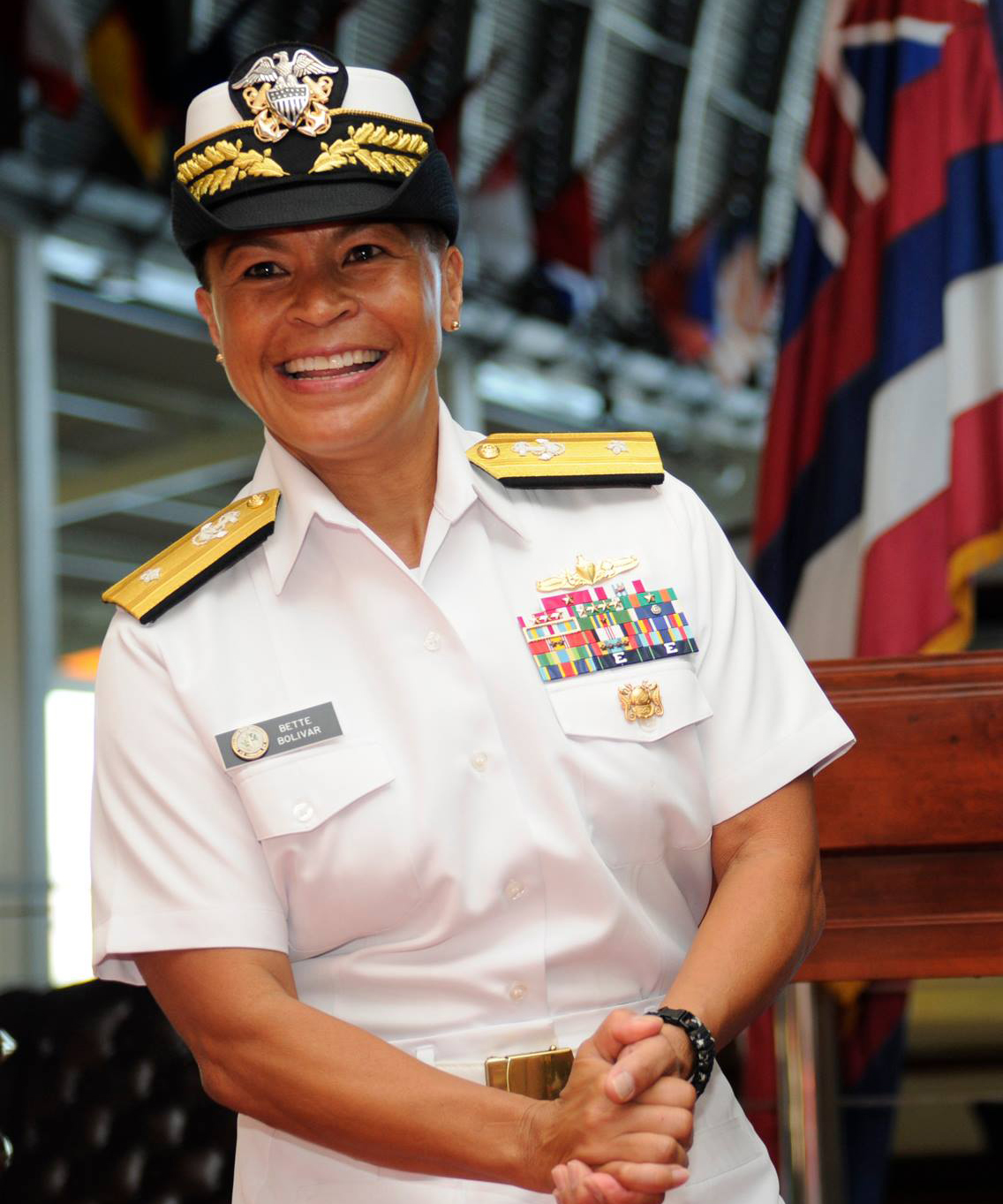
Rear Admiral Bette Bolivar
First female commanding officer of Mobile Diving and Salvage Unit One, 2003
As a child, Rear Admiral Bette Bolivar had a near-drowning experience that drove her to learn to swim and to conquer her fear of the water. She became a Navy special operations officer (EOD/diving and salvage), earning her initial diving qualification in 1989.
Bolivar served aboard five salvage ships, including commanding USS Salvor (ARS 52), and became the first female commanding officer of Mobile Diving and Salvage Unit One in 2003. During Operation Enduring Freedom, Rear Admiral Bolivar deployed to Afghanistan as officer in charge of the Counter Radio-Controlled Improvised Explosive Device (IED) Electronic Warfare program.
Ashore, among many leadership assignments, she has commanded Naval Weapons Station Yorktown, Navy Munitions Command CONUS East Division, Joint Region Marianas, Navy Region Northwest, Navy Region Southeast, and Navy Region Southwest. Rear Admiral Bolivar retired in 2021 with 36 years of service.
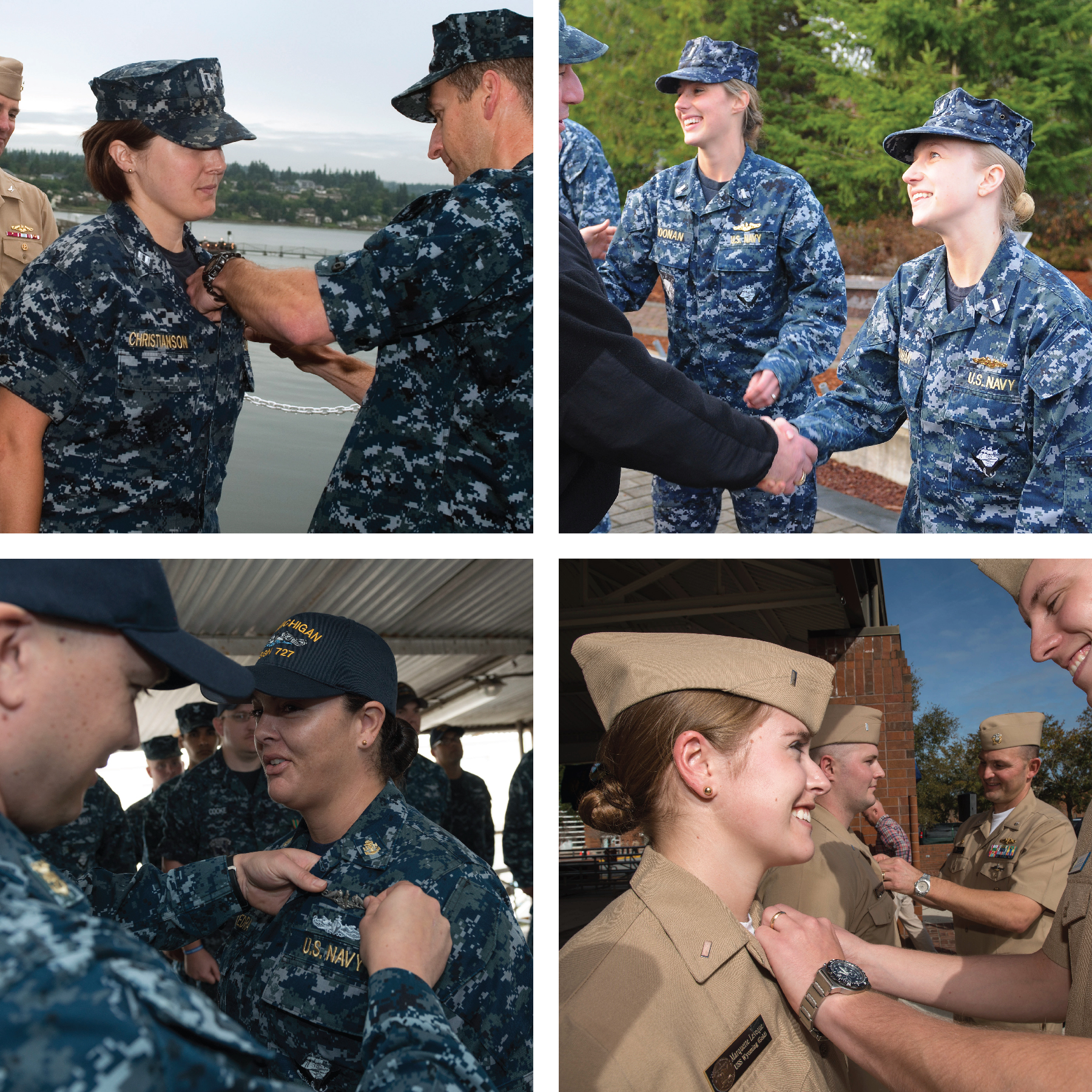
Clockwise from top left: Lieutenant Britta Christianson, Lieutenant j.g. Jennifer Noonan and Lieutenant j.g Amber Cowan, Lieutenant j.g. Marquette Leveque, and Chief Culinary Specialist Dominique Saavedra.
First Female Qualified Submariners
First female submariners to qualify in submarines, 2012 to 2016
In 2010, the Navy opened submarine service to women for the first time with the authorization of female officers aboard guided missile submarines. The first female submarine officers began serving in 2011. Four years later, the first enlisted women were selected for submarines and began service in 2016.
Lieutenant Britta Christianson became the first woman to qualify as a supply officer, earning her Supply Corps “dolphins” (qualification insignia) in June 2012 aboard USS Ohio (SSGN 726) (Gold). Six months later, three women earned their submarine dolphins, becoming the first female unrestricted line officers to do so. Lieutenant j.g Amber Cowan and Lieutenant j.g. Jennifer Noonan of USS Maine (SSBN 741) (Blue) and Lieutenant j.g. Marquette Leveque of USS Wyoming (SSBN 742) (Gold) were awarded their dolphins during ceremonies at Naval Base Kitsap-Bangor and Naval Submarine Base Kings Bay on December 5, 2012.
In August 2016, Chief Culinary Specialist Dominique Saavedra became the first enlisted woman to qualify in submarines, qualified aboard USS Ohio (SSGN 726) ahead of deploying aboard USS Michigan (SSGN 727).

Lieutenant Tabitha Strobel
One of the first female submarine officers, 2011
First African American woman to qualify in submarines, circa 2012
Lieutenant Tabitha Strobel graduated from the U.S. Naval Academy in 2010, the year the Navy opened submarine service to female officers. She was in the first class of women to integrate the U.S. Submarine Force in 2011, after successfully completing nuclear power training and submarine officer training. Strobel served as quality assurance officer on USS Georgia (SSGN 729) (Gold); there she became the first African American woman to qualify in submarines.
Since leaving the Navy in 2016, Strobel has continued to mentor other female submarine officers. “When you’re one of the first women to do something,” she reflected, “you want to make sure you’re not the last.”
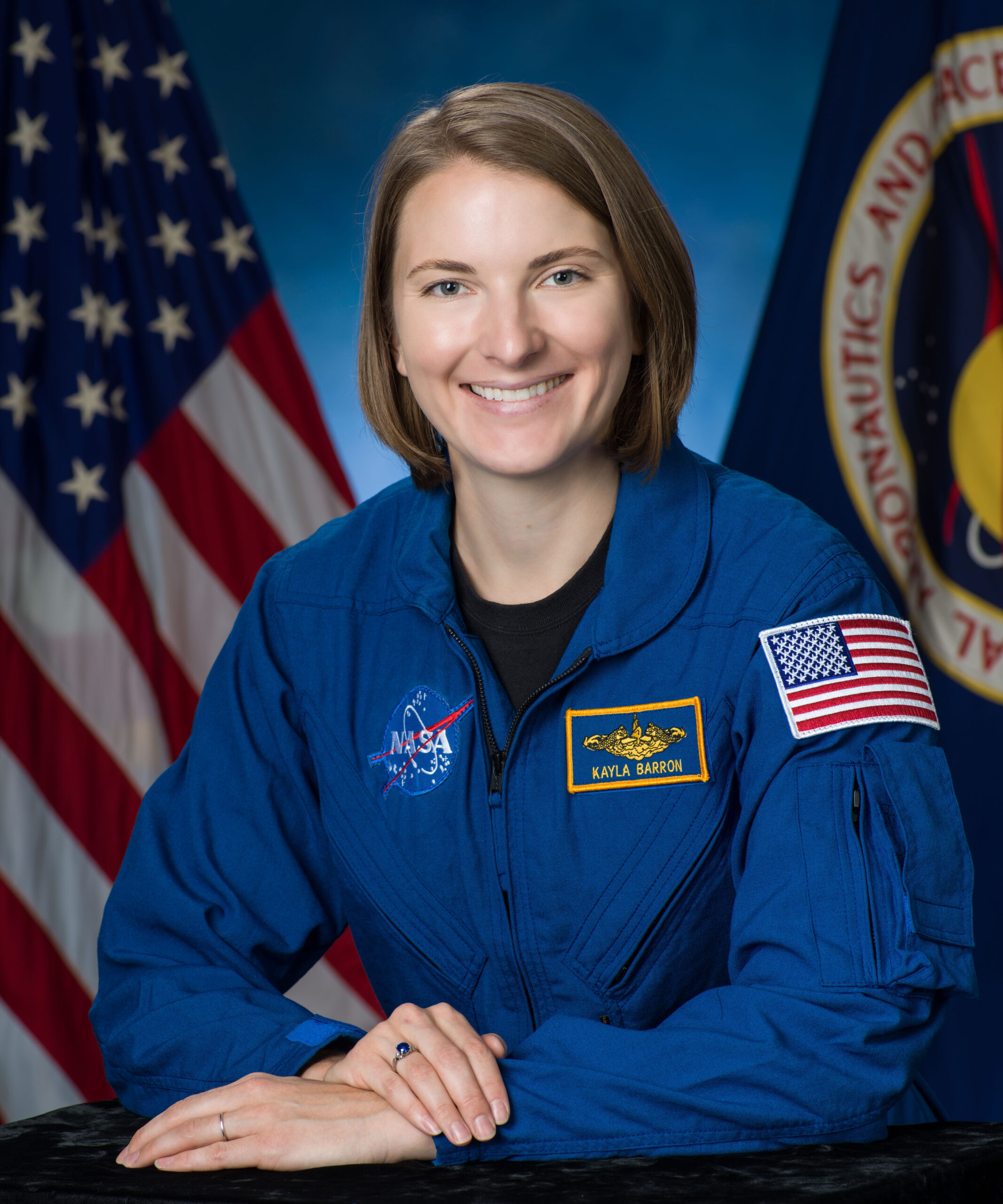
Photo courtesy of NASA
Lieutenant Commander Kayla Barron
One of the first female submarine officers, 2011
First female submariner in space, 2021
Lieutenant Commander Kayla Barron graduated from the U.S. Naval Academy, class of 2010. In 2011, she earned a master’s degree in nuclear engineering from the University of Cambridge, as Gates Cambridge Scholar, and was selected in the first class of female officers to integrate the U.S. Submarine Force. Barron made three strategic deterrent patrols aboard USS Maine (SSBN 741) between 2013 and 2015. “I really felt at home there,” she said of her time on Maine. “I think we’re all nerds of a certain variety. Everyone is really talented and team-oriented.”
In 2017, Barron was selected by NASA as an astronaut candidate, while serving as the Flag Aide to the Superintendent of the Naval Academy. After completing two years of astronaut candidate training, Barron was selected in May 2021 as a mission specialist of the NASA SpaceX Crew-3 mission to the International Space Station. With the launch of the mission in November 2021, Barron became the first female astronaut submariner, and the third submariner in space, after Captain Michael McCulley and Captain Steve Bowen.
